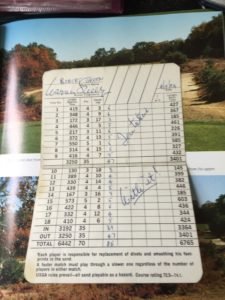I know the date because it’s on my scorecard: April 4, 1984. That was the first time I played Pine Valley Golf Club in Clementon, New Jersey – about 30 miles from Philadelphia, 100 from New York City. In the opinion of many people (myself included), it is the best course in the world. Every hole is aesthetically outstanding, every shot is thoroughly demanding. If you’re straight you’ll probably do OK; if you’re awry, you’ll need to be away to the pro shop for more ammo. There is no weak or even ordinary hole. They are either great or greater. It might be the ultimate matchplay golf course.
Pine Valley was the project of George Crump, a local hotelier who vanished into the New Jersey sandhills in 1913 to create his dream, sadly not living to see its completion shortly after his death in 1918. Harry Colt and other luminaries stepped in to fulfil his vision. And what a vision. I started my round on an overcast morning but who cared about the weather? I was so thrilled to be there. I had never wanted to play a golf course so much, even though – and sorry about this – I was fixed to be playing Augusta National a fortnight later.
At Pine Valley, there are tees, fairways, a few bunkers and 19 greens. (The 9th has alternative versions.) There is almost no rough. The rest is hellish, mostly sandy waste from which extracting one’s ball can be supremely difficult. The huge unraked Sahara that splits the fairway on the par-five 7th is called Hell’s Half-Acre. Granted, the target areas you will be aiming at are generous enough but the penalty for being off-line can be vicious. Every hole has its own anecdotes of golfing nightmares. Take the par-three 10th, the shortest hole on the course. A satanic pot bunker guards the front-right of the green. One man went in it after playing the front nine in 38. He carded 38 on the 10th alone. A fourball once completed it in an aggregate of 88 strokes.
But Pine Valley is not just about punishing golf. It is a very beautiful place. The trees – oak, fir and birch as well as pine – are magnificent. One visitor, on seeing the par-four 2nd for the first time, asked: “Do you play this or do you photograph it?” The splendid isolation of each hole seems almost mystical; a magical experience. Like the one once enjoyed by ‘Woody’ Platt, an eminent amateur of the day. Against a par of 4-4-3-4, he started 3-2-1-3. The clubhouse is close to the 4th green. As if befuddled by what he’d just done, six under through four holes, Platt retired to the bar. Still, an old club saying has it that ‘only God can make three on the 5th’ so perhaps he knew what he was doing.
I played my round with a gentleman named Warner Shelly, the oldest member. (I know that sounds like something out of P.G. Wodehouse.) Given how legendarily penal Pine Valley is, even playing off 11, I had to have been pretty happy to have shot 47 (12 over par) going out, with a par on the 3rd. But I don’t recall that. However, I do remember being amazed at starting back with three pars (take that, 10th!), two of them with two-putts; at making a 15-footer for a par-three on the lake-protected 14th, the hole I had been most looking forward to playing; and standing on the 18th tee knowing a bogey five would mean I had broken 40 for nine holes. At Pine Valley!! Achieving that eventually required the sinking of a five-footer but back then I possessed some semblance of a putting stroke and the ball managed to find the hole. Within ten minutes the rain was pouring down.
Mr Shelly not only signed my card but also autographed a copy of the club’s chronicle to me with the words: ‘For Robert Green, who beat the rain and the last nine today.’ I have been fortunate enough to play Pine Valley a few times since but, golf-wise, that was a day beyond compare.
Robert Green’s ‘Seve: Golf’s Flawed Genius’ is available on Amazon. You can follow him on Twitter @robrtgreen


